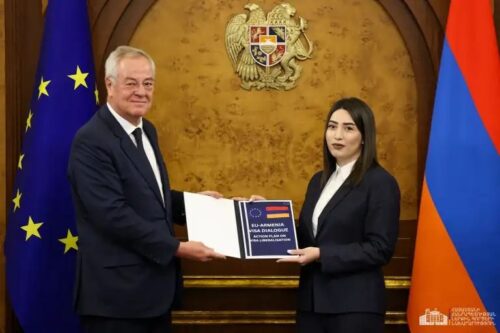
The Eraskh factory fully complies with international environmental standards: Armenia responds to Azerbaijan
The Ministry of Environment takes note of the open letter
sent by a number of alleged “civil society organizations” operating in the
Republic of Azerbaijan.
The claims made in the open letter are entirely without
foundation and are unworthy of a response. The Ministry of Environment
nonetheless wishes to briefly make the following points:
1. With respect to the alleged pollution of water resources
(mentioned in the preface of the open letter and its points 1-3), the Ministry
notes that there are water quality monitoring points in all transboundary
sections of rivers in Armenia, where the monitoring of all water quality
parameters, including heavy metals, is carried out at monthly intervals.
According to the law, mining enterprises monitor water quality and atmospheric
air and soil pollution, and the results are submitted to the Ministry in the
form of quarterly and annual reports, which are then published. At the same
time, Armenia is the only member country of the “Extractive Industries
Transparency Initiative” in the Caucasus region, which proves the
importance Armenia accords to open and accountable management of natural
resources.
2. In response to point 4 of the open letter, the Ministry
observes that the ”Sotk” gold mine was lawfully assigned to the Armenian
Soviet Socialist Republic in 1964, and so it now belongs to the Republic of
Armenia on the basis of succession. The open letter is simply wrong that the
European Court of Human Rights has ruled that Armenia has violated “rights to
ecological balance”; no such decision exists.
3. Point 5 of the open letter misrepresents the judgments of
the European Court of Human Rights of 14 February 2019. In those judgments, the
Court accepted that the implementation of the Teghout copper‑molybdenum deposit
exploitation project was in the public interest. It granted compensation to
Armenian nationals only because their properties had been expropriated for this
project. Contrary to what the open letter states, the Court did not consider
the mining activities in question to be illegal.
4. The mine with the name mentioned in point 6 of the letter
is neither located in nor operated by the Republic of Armenia.
5. As for the Akhtala Ore Processing Combine mentioned in
point 7 of the letter, it is being operated with a new technology, which does
not provide for the use of tailings.
6. The factory with the name mentioned in point 8 of the
open letter is neither located in nor operated by the Republic of Armenia.
7. What is mentioned in point 9 of the open letter does not
correspond to reality, because there is no factory engaged in the production of
copper, zinc and lead in the Kotayk region of the Republic of Armenia.
8. Point 10 of the open letter is also not true, because
there is no copper smelter in the Gegharkunik region of the Republic of
Armenia.
9. As for the Eraskh factory, it fully complies with
international environmental standards.
10. As for the Amulsar mine, it has not yet entered the
operational phase, so there is no question of any contamination. And when it
begins operation, the highest international benchmark of environmental risk
management will be followed, and its implementation will be strictly monitored,
including by international organizations.
11. It should be noted that the water leaving the borders of
Armenia corresponds to international norms. This was proven years ago, when the
Center for Ecological-Noosphere Studies National Academy of Sciences, with the
support of the North Atlantic Treaty Organization (NATO), conducted studies on
40 indicators at border points for 6 years, applying the same methodology
adopted jointly with neighboring countries within the framework of the
project,” reads the response of the ministry.


